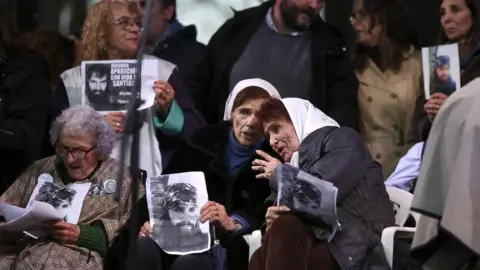Where is Santiago Maldonado? Argentina searches for missing protester
 Facebook
Facebook"Where is Santiago Maldonado?" Social media in Argentina is chiming with the same phrase, loaded with anger and frustration.
The protester, 28, went missing at an indigenous-rights demonstration in Patagonia at the start of August.
On a Saturday night talk show, the national security minister said she was sure the police were not involved.
Witnesses say Mr Maldonado was arrested and not seen again.
The police have denied detaining him.
 EPA
EPA "The police are not the same as 40 years ago," said Security Minister Patricia Bullrich, referring to the country's military dictatorship. Rights groups say up to 30,000 people "disappeared" when a brutal junta ruled from 1976 to 1983.
She urged people not to make the case a "political battle", saying the government and human rights organisations were aligned in trying to find out the truth.
But Argentina's history of political disappearances has made the case an extremely hot subject.
The government has offered a reward of almost US$30,000 (£23,000) for information on his disappearance.
The former president, now head of the opposition, Cristina Fernández de Kirchner has repeatedly spoken out on the disappearance, which also coincided with the first round of congressional elections.
"Santiago must reappear. And he must reappear alive," she tweeted.
The mystery gripping a nation
What happened on 1 August is entirely unclear.
"It truly is an enigma," said television host Mirtha Legrand, during her show when she grilled the security minister.
After the interview aired, Argentines ramped up the online protests, posting Facebook status updates with their name and current location, adding, "But where is Santiago Maldonado?"
"I am Mariana. I am in my house, waking up in the morning, and I want to know, where is Santiago Maldonado?" read a typical example, posted on Sunday.
Ms Bullrich has previously said there is no proof that Mr Maldonado was even present at the protest, which took place in Cushamen, in Chubut province, as "all the people were hooded".
The polarised Argentine press has been filled with rumours, from backing allegations that the police were involved to suggesting that an indigenous-rights protester of the Mapuche community killed him.
One witness account says he was seen when a group crossed a river to escape the police, who were said to be firing lead and rubber bullets.
"We saw him clinging to a tree, not crossing the river," Mapuche protester Soraya Maicoño told news site Infobae, saying he then went out of view after they heard someone tell him he was being detained. "After that, we did not see him again."
However, key witnesses have refused to testify in court, which the authorities say is hampering investigations.
The Mapuche's protest
The Cushamen protest was held to defy the detention of Mapuche leader Facundo Jones Huala, who heads the Ancestral Mapuche Resistance (RAM) separatist group.
Jones Huala is in a Chubut jail, and the Chilean government, which considers him a terrorist, has requested his extradition.
 EPA
EPA A community of Mapuche have been occupying land in the Chubut, claiming ancestral rights in a privately owned area.
On the day that Mr Maldonado disappeared, border police arrived to dismantle a roadblock which had been erected by protesters on Route 40, the main road that connects the country from north to south.
'I can't look at my son's face on a flag'
Earlier this month, a march was held in Buenos Aires calling for Santiago Maldonado's safe return.
Another march was held in the city of La Plata last week, but it took a violent turn when a protester threw a Molotov-type bomb at the provincial Senate building.
Mr Maldonado's brother insists his sibling is "not a militant or an activist", but just had empathy for the cause.
The craftsman, who was often travelling, had recently moved to the bohemian Patagonian town of El Bolsón, where he was living with others in a community library.
Now he is becoming a symbol for various conflicts, from indigenous rights to alleged government repression.
A giant mural of him has been created in his parents' home town in Buenos Aires province.
"I can't look at my son's face on a flag or in a mural," said his father, Enrique, in an interview with La Nación newspaper on Friday. "Please let him reappear. Where is he? What have they done to him?"
The family say they have agreed to give samples of blood and saliva to check with the DNA of blood and hair found in a police van.
